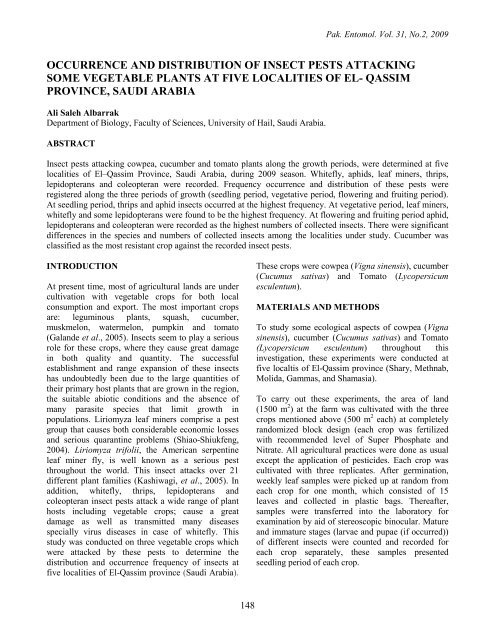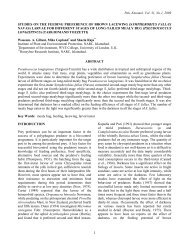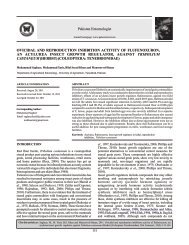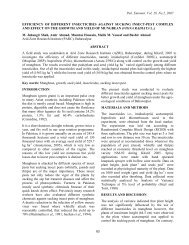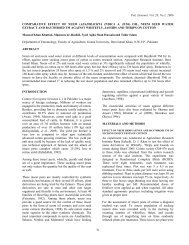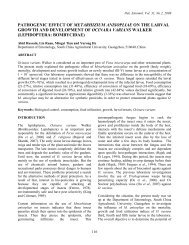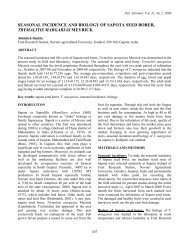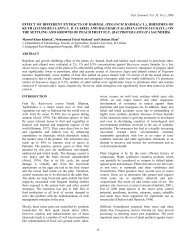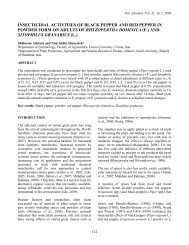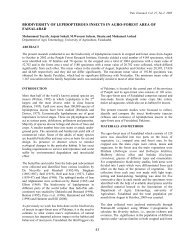occurrence and distribution of insect pests attacking some vegetable ...
occurrence and distribution of insect pests attacking some vegetable ...
occurrence and distribution of insect pests attacking some vegetable ...
Create successful ePaper yourself
Turn your PDF publications into a flip-book with our unique Google optimized e-Paper software.
Pak. Entomol. Vol. 31, No.2, 2009OCCURRENCE AND DISTRIBUTION OF INSECT PESTS ATTACKINGSOME VEGETABLE PLANTS AT FIVE LOCALITIES OF EL- QASSIMPROVINCE, SAUDI ARABIAAli Saleh AlbarrakDepartment <strong>of</strong> Biology, Faculty <strong>of</strong> Sciences, University <strong>of</strong> Hail, Saudi Arabia.ABSTRACTInsect <strong>pests</strong> <strong>attacking</strong> cowpea, cucumber <strong>and</strong> tomato plants along the growth periods, were determined at fivelocalities <strong>of</strong> El–Qassim Province, Saudi Arabia, during 2009 season. Whitefly, aphids, leaf miners, thrips,lepidopterans <strong>and</strong> coleopteran were recorded. Frequency <strong>occurrence</strong> <strong>and</strong> <strong>distribution</strong> <strong>of</strong> these <strong>pests</strong> wereregistered along the three periods <strong>of</strong> growth (seedling period, vegetative period, flowering <strong>and</strong> fruiting period).At seedling period, thrips <strong>and</strong> aphid <strong>insect</strong>s occurred at the highest frequency. At vegetative period, leaf miners,whitefly <strong>and</strong> <strong>some</strong> lepidopterans were found to be the highest frequency. At flowering <strong>and</strong> fruiting period aphid,lepidopterans <strong>and</strong> coleopteran were recorded as the highest numbers <strong>of</strong> collected <strong>insect</strong>s. There were significantdifferences in the species <strong>and</strong> numbers <strong>of</strong> collected <strong>insect</strong>s among the localities under study. Cucumber wasclassified as the most resistant crop against the recorded <strong>insect</strong> <strong>pests</strong>.INTRODUCTIONAt present time, most <strong>of</strong> agricultural l<strong>and</strong>s are undercultivation with <strong>vegetable</strong> crops for both localconsumption <strong>and</strong> export. The most important cropsare: leguminous plants, squash, cucumber,muskmelon, watermelon, pumpkin <strong>and</strong> tomato(Gal<strong>and</strong>e et al., 2005). Insects seem to play a seriousrole for these crops, where they cause great damagein both quality <strong>and</strong> quantity. The successfulestablishment <strong>and</strong> range expansion <strong>of</strong> these <strong>insect</strong>shas undoubtedly been due to the large quantities <strong>of</strong>their primary host plants that are grown in the region,the suitable abiotic conditions <strong>and</strong> the absence <strong>of</strong>many parasite species that limit growth inpopulations. Liriomyza leaf miners comprise a pestgroup that causes both considerable economic losses<strong>and</strong> serious quarantine problems (Shiao-Shiukfeng,2004). Liriomyza trifolii, the American serpentineleaf miner fly, is well known as a serious pestthroughout the world. This <strong>insect</strong> attacks over 21different plant families (Kashiwagi, et al., 2005). Inaddition, whitefly, thrips, lepidopterans <strong>and</strong>coleopteran <strong>insect</strong> <strong>pests</strong> attack a wide range <strong>of</strong> planthosts including <strong>vegetable</strong> crops; cause a greatdamage as well as transmitted many diseasesspecially virus diseases in case <strong>of</strong> whitefly. Thisstudy was conducted on three <strong>vegetable</strong> crops whichwere attacked by these <strong>pests</strong> to determine the<strong>distribution</strong> <strong>and</strong> <strong>occurrence</strong> frequency <strong>of</strong> <strong>insect</strong>s atfive localities <strong>of</strong> El-Qassim province (Saudi Arabia).These crops were cowpea (Vigna sinensis), cucumber(Cucumus sativas) <strong>and</strong> Tomato (Lycopersicumesculentum).MATERIALS AND METHODSTo study <strong>some</strong> ecological aspects <strong>of</strong> cowpea (Vignasinensis), cucumber (Cucumus sativas) <strong>and</strong> Tomato(Lycopersicum esculentum) throughout thisinvestigation, these experiments were conducted atfive localtis <strong>of</strong> El-Qassim province (Shary, Methnab,Molida, Gammas, <strong>and</strong> Shamasia).To carry out these experiments, the area <strong>of</strong> l<strong>and</strong>(1500 m 2 ) at the farm was cultivated with the threecrops mentioned above (500 m 2 each) at completelyr<strong>and</strong>omized block design (each crop was fertilizedwith recommended level <strong>of</strong> Super Phosphate <strong>and</strong>Nitrate. All agricultural practices were done as usualexcept the application <strong>of</strong> pesticides. Each crop wascultivated with three replicates. After germination,weekly leaf samples were picked up at r<strong>and</strong>om fromeach crop for one month, which consisted <strong>of</strong> 15leaves <strong>and</strong> collected in plastic bags. Thereafter,samples were transferred into the laboratory forexamination by aid <strong>of</strong> stereoscopic binocular. Mature<strong>and</strong> immature stages (larvae <strong>and</strong> pupae (if occurred))<strong>of</strong> different <strong>insect</strong>s were counted <strong>and</strong> recorded foreach crop separately, these samples presentedseedling period <strong>of</strong> each crop.148
Pak. Entomol. Vol. 31, No.2, 2009One month later, weekly leaf samples were picked upat r<strong>and</strong>om from each crop, which consist <strong>of</strong> 15 leavesthat collected in plastic bags representing vegetativeperiod <strong>of</strong> each crop. Mature <strong>and</strong> immature stages(larvae <strong>and</strong> pupae (if occurred)) <strong>of</strong> different <strong>insect</strong>swere counted <strong>and</strong> recorded for each crop separately.Two months later, weekly leaf samples were pickedup at r<strong>and</strong>om from each crop, which consist <strong>of</strong> 15leaves that collected in plastic bags representingvegetative period <strong>of</strong> each crop. Mature <strong>and</strong> immaturestages (larvae <strong>and</strong> pupae if occurred) <strong>of</strong> different<strong>insect</strong>s were counted <strong>and</strong> recorded for each cropseparately.At the end <strong>of</strong> experiments, results <strong>of</strong> the <strong>insect</strong>s werestatistically analyzed using Costat computer programto determine the analysis <strong>of</strong> variance at 5% level.Frequency <strong>occurrence</strong> <strong>of</strong> different <strong>insect</strong> species wascalculated at the five localities under investigation.Data were statistically analyzed using Computerprogram <strong>of</strong> Costat 22 (1998) multiple test (ANOVA).RESULTS AND DISCUSSION1- Insect population <strong>attacking</strong> leaves <strong>and</strong> pods <strong>of</strong>cowpea plants cultivated at five localities <strong>of</strong>El-Qassim province:Data presented in Table 1, recorded six <strong>insect</strong> <strong>pests</strong> incowpea fields at the five localities underinvestigation (Shary, Methnab, Molida, Gammas,<strong>and</strong> Shamasia). These <strong>insect</strong>s included aphids, thrips,white fly, leaf miners, cotton leaf worm, bean podworm, American boll worm, cucurbita beetle.At seedling period, there were five species <strong>of</strong> <strong>insect</strong>s,the highest numbers were recorded with white flyfollowed by aphids, thrips, leaf miners, cotton leafworm.Table 1:localitiesAverage numbers <strong>of</strong> <strong>insect</strong> <strong>pests</strong> infesting cowpea plants at five localities <strong>of</strong> El-QassimProvince, Saudi Arabia.Average numbers <strong>of</strong> <strong>insect</strong> stages per leafaphids thrips white flyleafminerscottonleafwormbean podwormAmericanbollwormcucurbitabeetleat seedling periodShary 3.3 bc 3.0 a 10.7a 6.0 bc 10.7 a 0.0 0.0 0.0Methnab 4.0 ab 2.3 a 8.0 ab 8.0abc 12.3ab 0.0 0.0 0.0Molida 4.0 ab 2.7 a 7.3 ab 12.7a 15.7 a 0.0 0.0 0.0Gammas 2.0 c 1.3 a 7.7 ab 10.3ab 0.0 c 0.0 0.0 0.0Shamasia 5.7 a 0.0 a 5.0 b 3.3 c 0.0 c 0.0 0.0 0.0LSD 5 % 1.8 3.0 4.0 5.2 4.7 - - -at vegetative periodShary 17.7 a 0.0 35.7 a 5.7 a 9.3 a 0.0 0.0 0.0Methnab 12.7 b 0.0 25.7 b 3.0ab 6.0 b 0.0 0.0 0.0Molida 10.0bc 0.0 20.3bc 3.3ab 6.3 b 0.0 0.0 0.0Gammas 13.0b 0.0 15.3cd 2.3ab 0.0 c 0.0 0.0 0.0Shamasia 8.3 c 0.0 10.3 d 0.0 b 0.0 c 0.0 0.0 0.0LSD 5 % 3.6 - 9.1 3.3 2.8 - - -at flowering <strong>and</strong> fruiting periodShary 2.0 b 0.0 10.0 b 0.0 0.0 12.7a 0.0 0.0Methnab 4.7 a 0.0 12.7ab 0.0 0.0 10.0ab 0.0 0.0Molida 4.3 a 0.0 13.0ab 0.0 0.0 8.0 b 0.0 0.0Gammas 2.0 b 0.0 14.7 a 0.0 0.0 3.3 c 0.0 0.0Shamasia 1.3 b 0.0 5.3 c 0.0 0.0 2.3 c 0.0 0.0LSD 5 % 1.8 - 3.6 - - 3.6 - -Data are means <strong>of</strong> 15 replicates. Means in columns followed by the same letter (s) are not significantly differentat 5%.149
Pak. Entomol. Vol. 31, No.2, 2009Shary, Methnab, Molida localities could be classifiedas highly infested localities while Gammas, <strong>and</strong>Shamasia recorded as the least infected. At vegetativeperiod, the numbers <strong>of</strong> white fly <strong>insect</strong>s were sharplyincreased, in addition aphids <strong>insect</strong>s were increased,while there were no individuals <strong>of</strong> thrips <strong>insect</strong>s. Asfor the variation in the infestation among localitiesShary, Methnab, <strong>and</strong> Molida localities were higherinfested with <strong>insect</strong>s than the other two localities.Statistical analysis <strong>of</strong> the data indicated significantdifferences in the numbers <strong>of</strong> <strong>insect</strong>s among the fivelocalities under study.At flowering <strong>and</strong> fruiting period, population numbers<strong>of</strong> <strong>insect</strong>s was sharply declined except aphids <strong>and</strong>white fly, it could be noticed the presence <strong>of</strong> beanpod worm.2- Insect population <strong>attacking</strong> leaves <strong>and</strong> fruits<strong>of</strong> tomato plants cultivated at five localities <strong>of</strong>El- Qassim province:Data presented in Table 2, recorded six <strong>insect</strong> <strong>pests</strong> intomato fields at the five localities under investigation(Shary, Methnab, Molida, Gammas, <strong>and</strong> Shamasia),these <strong>insect</strong>s are, aphids, thrips, white fly, leafminers, cotton leaf worm, <strong>and</strong> the American bollworm.At seedling period, there were only four species <strong>of</strong><strong>insect</strong>s. The highest numbers were recorded withwhite fly followed by aphids, thrips <strong>and</strong> leaf miners.Shary, Methnab, Molida localities could be classifiedas highly infested localities while Gammas <strong>and</strong>Shamasia localities recorded the least ones with anexception in the numbers <strong>of</strong> aphids where the highestnumbers <strong>of</strong> aphids was recorded at Gammas locality.At vegetative period, the numbers <strong>of</strong> white fly <strong>insect</strong>swere sharply increased. In addition aphids wereincreased at Shary <strong>and</strong> Methnab localities <strong>and</strong>decreased at the rest localities, while there were noindividuals <strong>of</strong> thrips. Infestations <strong>of</strong> cotton leaf wormwere found at all localities.As for the variation in the infestation amonglocalities Shary, Methnab <strong>and</strong> Molida localities werehighly infested with <strong>insect</strong>s than the other twolocalities with significant differences.Statistical analysis <strong>of</strong> the data indicated significantdifferences in the numbers <strong>of</strong> <strong>insect</strong>s among the fivelocalities under study.At flowering <strong>and</strong> fruiting period, population numbers<strong>of</strong> <strong>insect</strong>s was sharply declined except aphids <strong>and</strong>whitefly, however, the presence <strong>of</strong> Americanbollworm, was noticed.3- Insect population <strong>attacking</strong> leaves <strong>and</strong> fruits<strong>of</strong> cucumber plants cultivated at five localities<strong>of</strong> El- Qassim province:Data presented in Table (3) recorded only four <strong>insect</strong><strong>pests</strong> in cucumber fields at the five localities underinvestigation (Shary, Methnab, Molida, Gammas, <strong>and</strong>Shamasia). These <strong>insect</strong>s included aphids, thrips,white fly, leaf miners <strong>and</strong> cucurbita beetle.At seedling period, there were only four species <strong>of</strong><strong>insect</strong>s, the highest numbers were recorded withwhite fly followed by aphids, thrips <strong>and</strong> leaf miners.It was noticed that there were no thrips in theGammas <strong>and</strong> Shamasia localities. Shary, Methnab,Molida localities could be classified as highlyinfested localities while Gammas <strong>and</strong> Shamasialocalities recorded as least effected. There weresignificant differences in the numbers <strong>of</strong> <strong>insect</strong>sbetween Shary, Methnab, Molida localities <strong>and</strong> theothers.At vegetative period, the numbers <strong>of</strong> white fly <strong>and</strong>aphids were sharply increased, while there were noindividuals <strong>of</strong> thrips at all localities. Cucurbita beetlewas recorded at Shary, Methnab, Molida localitieswith a few numbers without significant differences.As for the variation in the infestation amonglocalities Shary, Methnab, <strong>and</strong> Molida localitieswere highly infested with <strong>insect</strong>s than the other twolocalities.At flowering <strong>and</strong> fruiting period, population numbers<strong>of</strong> aphids, white fly <strong>and</strong> cucurbita beetle <strong>insect</strong>s weresharply declined with no significant differencesamong the three localities (Shary, Methnab <strong>and</strong>Molida). At flowering <strong>and</strong> fruiting period, Gammas<strong>and</strong> Shamasia localities infested only with white fly<strong>insect</strong>s. In addition, there were significant differencesin the numbers <strong>of</strong> <strong>insect</strong>s between Shary, Methnab,Molida localities <strong>and</strong> the other two localities.150
Pak. Entomol. Vol. 31, No.2, 2009Table 2:localitiesAverage numbers <strong>of</strong> <strong>insect</strong> <strong>pests</strong> infesting tomato plants at five localities <strong>of</strong> El- QassimProvince, Saudi Arabia.Average numbers <strong>of</strong> <strong>insect</strong> stages per leafaphids thrips white flyleafminersat seedling periodcottonleafwormbean podwormAmericanbollwormShary 12.3bc 10.0ab 35.7ab 10.7 a 0.0 0.0 0.0 0.0Methnab 15.0ab 12.3a 42.3a 12.7 a 0.0 0.0 0.0 0.0Molida 17.7a 11.0ab 33.3 b 8.3 ab 0.0 0.0 0.0 0.0Gammas 18.3a 8.3 b 25.7 c 6.0 ab 0.0 0.0 0.0 0.0Shamasia 10.0 c 2.7 c 17.0 d 2.3 b 0.0 0.0 0.0 0.0LSD 5 % 3.6 3.3 7.1 6.8 - - - -at vegetative periodShary 20.3 a 0.0 43.3 a 12.7 a 12.3 a 0.0 0.0 0.0Methnab 18.3 a 0.0 48.0 a 14.3 a 10.3ab 0.0 0.0 0.0Molida 16.0ab 0.0 32.0 b 16.0 a 10.0ab 0.0 0.0 0.0Gammas 10.0bc 0.0 28.7 b 4.7 b 8.0 b 0.0 0.0 0.0Shamasia 6.0 c 0.0 15.3 c 2.3 b 4.0 c 0.0 0.0 0.0LSD 5 % 7.6 - 5.5 6.6 3.3 - - -at flowering <strong>and</strong> fruiting periodShary 5.3 a 0.0 33.3 a 0.0 0.0 0.0 2.3 b 0.0Methnab 3.3 a 0.0 22.7 b 0.0 0.0 0.0 4.7 a 0.0Molida 0.0 b 0.0 17.0 b 0.0 0.0 0.0 4.7 a 0.0Gammas 0.0 b 0.0 10.3 c 0.0 0.0 0.0 2.3 b 0.0Shamasia 0.0 b 0.0 8.7 c 0.0 0.0 0.0 1.3 b 0.0cucurbitabeetleLSD 5 % 2.3 - 5.8 - - - 1.6 -Data are means <strong>of</strong> 15 replicates. Means in columns followed by the same letter (s) are not significantly differentat 5%.4- Frequency <strong>occurrence</strong> percentages <strong>of</strong> <strong>insect</strong><strong>pests</strong> infesting three <strong>vegetable</strong> crops at fivelocalities <strong>of</strong> El- Qassim Province, SaudiArabiaData presented in Table (4) indicated that there wereeight <strong>insect</strong> kinds infesting the three <strong>vegetable</strong> cropsunder investigation (Cowpea, Tomato, Cucumber),These <strong>insect</strong>s were aphids i.e. Aphis gossypii,,Brevicoryne brassica (L.), Aphis craccivora (Koch),Aphis pomi, Thrips, (Thrips tabaci), White fly(Bemesia tabaci), leaf miners (Liriomyza trifolii),cotton leaf worm (Spodoptera littoralis), bean podworm (Etiella zinckenella) American boll worm(Heliothis armigera) <strong>and</strong> cucurbita beetle, Epilachnachry<strong>some</strong>lina.On cowpea plants, the percentages <strong>of</strong> <strong>occurrence</strong> <strong>of</strong>aphids, thrips, whitefly, leaf miners, cotton leafworm, bean pod worm, American boll worm, <strong>and</strong>cucurbita beetle were 80.1, 40, 80.2, 48, 44, 30, 0,<strong>and</strong> 0 %, respectively.On tomato plants, the percentages <strong>of</strong> <strong>occurrence</strong> <strong>of</strong>aphids, thrips, whitefly, leaf miners, cotton leafworm, bean pod worm, American boll worm, <strong>and</strong>151
Pak. Entomol. Vol. 31, No.2, 2009Table 4:localitiesFrequency <strong>occurrence</strong> % <strong>of</strong> <strong>insect</strong> <strong>pests</strong> infesting three <strong>vegetable</strong> plants at five localities <strong>of</strong> Al-Qassim Province, Saudi Arabia.Average numbers <strong>of</strong> frequency <strong>occurrence</strong> % <strong>of</strong> <strong>insect</strong> <strong>pests</strong>aphids thrips white flyleafminerscottonleafwormbean podwormAmericanbollwormcucur-bitabeetleCowpea plantsShary 90 65 95 70 75 50 0 0Methnab 90 55 95 60 75 40 0 0Molida 90 50 85 50 70 30 0 0Gammas 75 30 75 40 0 20 0 0Shamasia 60 0 60 20 0 10 0 0Mean 80.1 40 80.2 48 44 30 0 0Tomato plantsShary 90 70 90 75 60 0 40 0Methnab 95 60 90 70 50 0 40 0Molida 95 50 90 60 50 0 30 0Gammas 80 50 80 50 40 0 20 0Shamasia 60 20 70 35 20 0 10 0Mean 85 50 85 58 44 0 28 0Cucumber plantsShary 95 50 95 70 0 0 0 50Methnab 95 40 95 60 0 0 0 30Molida 85 30 85 50 0 0 0 25Gammas 80 0 80 20 0 0 0 0Shamasia 70 0 60 10 0 0 0 0Mean 85 24 83 42 0 0 0 21REFERENCESCostat 22, 1998. A computer program for statisticalanalysis.Dong, C., Y. J. Zhang, J. K. Brown, Bin Cong, B. Y.Xu, Q. J. Wu <strong>and</strong> G. R. Zhu, 2006. Theintroduction <strong>of</strong> the exotic q biotype <strong>of</strong> Bemisiatabaci from the Mediterranean region into chinaon ornamental crops. Fla. Entomol., 89(2) :168-174.Gal<strong>and</strong>e, S. M., U. N. Mote <strong>and</strong> S. A. Ghorpade,2005. Host range <strong>of</strong> serpentine leaf miner(Liriomyza trifolii Burgess) <strong>and</strong> its activity inscarcity zone. J. Maharashtra Agric. Univ., 30(3): 307-310.Kashiwagi, T., Y. Horibata, D. B. Mekuria, S.Tebayashi <strong>and</strong> K. Chulsa, 2005. Ovipositionaldeterrent in the sweet pepper, Capsicumannuum, at the mature stage against Liriomyzatrifolii. Biosci. Biotechnol. Bio-chem., 69(10):1831-1835.Mansaray, A. <strong>and</strong> A. J. Sundufu, 2009. Oviposition,development <strong>and</strong> survivorship <strong>of</strong> the sweetpotato whitefly Bemisia tabaci on soybean,Glycine max, <strong>and</strong> the garden bean, Phaseolusvulgaris. J. Insect Sci., 9(1): 1-6.Ramesh, R. <strong>and</strong> S. P. Ukey, 2007. Bio-efficacy <strong>of</strong>botanicals, microbials, <strong>and</strong> newer <strong>insect</strong>icides inthe management <strong>of</strong> tomato leaf miner, Liriomyzatrifolii (Burgess). Intern. J. Agric. Sci., 3(1):154-156.Sahoo, S. K. <strong>and</strong> K. Karmakar, 2004. Screening <strong>of</strong>pumpkin cultivars against leaf miner (Liriomyzatrifolii Burgess) (Agromyzidae: Diptera) <strong>and</strong>white fly (Bemisia tabasi Genn.) (Aleyrodidae:Hemipters). J. Inter. Acad., 8(4): 575-581.Saradhi, P. M. <strong>and</strong> N. C. Patnaik, 2004. Seasonalpopulation fluctuation <strong>of</strong> serpentine leaf miner,153
Pak. Entomol. Vol. 31, No.2, 2009Liriomyza trifolii (Burgess) in different hostplants. J. Appl. Zool. Researches., 15(1): 60-63.Shiao Shiuh Feng, 2004. Morphological diagnosis <strong>of</strong>six Liriomyza species (Diptera: Agromyzidae) <strong>of</strong>quarantine importance in Taiwan. Appl.Entomol. Zool., 39(1): 27-39.Solangi, B. K. <strong>and</strong> M. K. Lohar, 2005. Cultivarresistance <strong>of</strong> Lineed against Bemisia tabaci <strong>and</strong>Heilcoverpa armigera. Asian J. Pl. Sci., 4(6):648-651.Vishal, Mittal <strong>and</strong> Ram, Ujagir, 2005. Response <strong>of</strong>pea, Pisum sativum L. cultivars for incidence<strong>and</strong> resistance against major <strong>insect</strong> <strong>pests</strong>.Environ. Ecol., 23(3): 611-619.154


